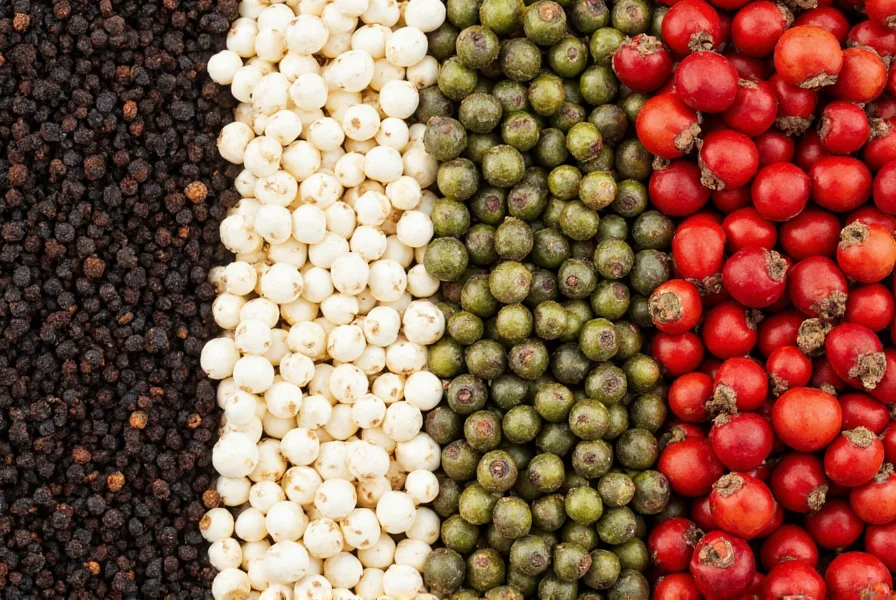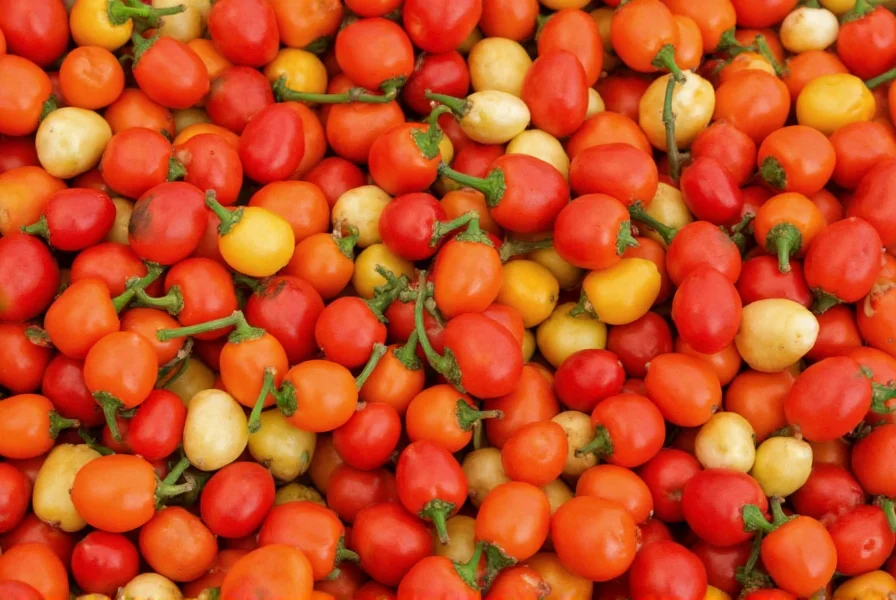Understanding the different types of peppercorns and their unique characteristics can transform your cooking and help you make informed choices when selecting this versatile spice. Whether you're a home cook or professional chef, knowing how to properly use and store peppercorns enhances flavor profiles in countless dishes.

The Botanical Background of Peppercorns
Peppercorns come from Piper nigrum, a perennial climbing vine that grows in tropical climates. The plant produces small, green berries that turn red when fully ripe. These berries are harvested at different stages and processed in various ways to create the different peppercorn varieties we know today. Contrary to common misconception, all peppercorn colors originate from the same plant species, not different plants.
Types of Peppercorns and Their Processing Methods
Despite common belief, all peppercorn varieties originate from the same plant. The differences arise from harvest timing and processing:
| Type of peppercorns | Harvest Stage | Processing Method | Flavor Profile |
|---|---|---|---|
| Black Peppercorns | Half-ripe green berries | Sun-dried, causing outer layer to shrivel and turn black | Most pungent, complex, with earthy notes |
| White Peppercorns | Fully ripe red berries | Soaked to remove outer layer, leaving only seed | Milder, less complex, slightly fermented |
| Green Peppercorns | Unripe green berries | Preserved through freeze-drying, brining, or sulfur dioxide | Fresh, herbal, less spicy |
| Red Peppercorns | Fully ripe red berries | Quickly dried or preserved in brine/vinegar | Fruity, floral, less pungent than black |
Culinary Applications of Different Peppercorn Varieties
Each peppercorn type serves specific purposes in cooking, making them essential components in any well-stocked spice collection. Understanding when to use each variety elevates your culinary creations significantly.
Black Peppercorns
The most versatile variety, black peppercorns work well in almost any savory dish. Whole black peppercorns are ideal for pickling, stocks, and marinades, while freshly ground black pepper enhances steaks, roasted vegetables, and creamy sauces. The robust flavor stands up well to high-heat cooking. When selecting black peppercorns, look for Tellicherry variety for the most complex flavor profile among black peppercorn types.
White Peppercorns
Common in French and Chinese cuisines, white pepper's milder heat makes it perfect for light-colored dishes where black specks would be visually distracting. It's traditionally used in béchamel sauces, potato salads, and seafood dishes. Some chefs prefer white pepper in certain meat preparations for its different flavor profile. The difference between black and white pepper extends beyond appearance to their chemical composition, affecting how they interact with other ingredients.
Green Peppercorns
With their fresh, herbal quality, green peppercorns shine in dishes where you want pepper flavor without intense heat. They're excellent in creamy sauces, salad dressings, and with fish. Often sold in jars preserved in brine, they add a distinctive pop of flavor to dishes like steak au poivre. When substituting green peppercorns for black, consider the unique characteristics of green peppercorns in your recipe adjustments.
Red Peppercorns
The rarest and most delicate variety, red peppercorns offer a unique fruity flavor with subtle heat. Best used sparingly as a finishing spice, they complement fruit-based sauces, duck dishes, and even some desserts. Due to their perishability, they're often found freeze-dried or preserved in liquid. Red peppercorns vs black peppercorns reveals significant flavor differences that can transform a dish's character.
Nutritional Profile and Potential Health Benefits
Peppercorns contain piperine, the compound responsible for their pungency, which has been studied for various health benefits:
- Enhanced nutrient absorption - Piperine increases the bioavailability of certain nutrients and compounds
- Antioxidant properties - Peppercorns contain antioxidants that may help combat oxidative stress
- Potential digestive benefits - Traditional medicine has used pepper to support digestion
- Anti-inflammatory effects - Some research suggests piperine may have anti-inflammatory properties
- Metabolic support - Studies indicate piperine may support healthy metabolism
While peppercorns are typically used in small quantities, their potential health benefits make them more than just a flavoring agent. The health benefits of peppercorns extend beyond basic nutrition to potential therapeutic applications.
Selecting and Storing Peppercorns
To maximize flavor and shelf life when working with different peppercorn varieties:
- Buying tips: Purchase whole peppercorns rather than pre-ground pepper whenever possible for superior flavor. Look for uniform color and size with no signs of moisture.
- Storage: Keep in airtight containers away from light and heat; whole peppercorns retain flavor for 1-2 years. Avoid storing near strong-smelling foods as peppercorns can absorb odors.
- Grinding: Use a pepper mill just before serving for maximum flavor impact. Different peppercorn types may require slight adjustments to your mill settings.
- Freshness test: Crush a single peppercorn between your fingers - fresh ones will have a strong aroma and slightly moist interior.

Peppercorn Substitutions and Creative Uses
When you run out of a specific peppercorn variety, consider these alternatives that maintain the integrity of your dish:
- Black pepper can substitute for white pepper in most recipes, though it will add visual specks. For dishes where appearance matters, this substitution requires consideration.
- In light-colored sauces, white pepper can replace black pepper for a cleaner look without compromising flavor balance.
- Green peppercorns can be replaced with capers for a similar briny quality in some recipes, though the flavor profile differs.
- For red peppercorn's fruity note, try a small amount of allspice or pink peppercorns (from a different plant) as alternatives.
Chefs often create custom peppercorn blends by combining different varieties for complex flavor profiles. Try mixing black and green peppercorns for a balance of heat and freshness, or combine black and red for depth with a hint of fruitiness. Understanding peppercorn substitution options ensures your recipes succeed even when specific varieties aren't available.
Historical Significance of Peppercorns
Peppercorns have played a significant role throughout history, influencing trade routes and culinary traditions:
- In ancient Rome, peppercorns were so valuable they were used as currency and even demanded as ransom
- During the Middle Ages, peppercorns were literally worth their weight in gold, driving exploration and trade
- The search for direct sea routes to pepper-producing regions fueled European exploration and colonization
- In some historical periods, peppercorns were placed in the nostrils of mummies for preservation
- The term "peppercorn rent" originates from using a single peppercorn as symbolic payment for property
This historical context explains why we still say someone is "worth their weight in pepper" when they're particularly valuable. The global journey of peppercorns has shaped culinary traditions worldwide, making them one of the most influential spices in human history.
Frequently Asked Questions About Peppercorns
What's the difference between black and white peppercorns?
Black and white peppercorns come from the same plant but differ in processing. Black peppercorns are made from unripe green berries that are sun-dried, causing them to turn black. White peppercorns come from fully ripe red berries with the outer layer removed through soaking, leaving only the seed. This results in black pepper having a more complex, pungent flavor while white pepper is milder with slightly fermented notes. The difference between black and white pepper extends to their chemical composition, affecting how they interact with other ingredients in cooking.
Can I substitute green peppercorns for black peppercorns in recipes?
Yes, but with flavor adjustments. Green peppercorns have a fresher, more herbal flavor with less heat than black peppercorns. When substituting, use about 25% more green peppercorns to achieve similar heat level, or combine with a small amount of black pepper for complexity. Green peppercorns work particularly well in creamy sauces, fish dishes, and salad dressings where their delicate flavor shines. Understanding peppercorn substitution options ensures your recipes maintain their intended flavor profile even when specific varieties aren't available.
Why are some peppercorns more expensive than others?
Price differences stem from harvesting methods, rarity, and processing. Black peppercorns are most common and affordable. White pepper requires additional processing to remove the outer layer. Green peppercorns need special preservation methods. Red peppercorns are the rarest as they must be harvested at full ripeness and quickly preserved, making them significantly more expensive. Specialty blends and organic varieties also command higher prices. The cost of different peppercorn types reflects both their availability and the labor-intensive processes required to produce certain varieties.
How can I maximize the flavor of peppercorns in my cooking?
For maximum flavor, always use whole peppercorns and grind them fresh just before serving. Store peppercorns in airtight containers away from light and heat. Different cooking methods affect pepper's flavor: add whole peppercorns early in slow-cooked dishes, but add freshly ground pepper near the end of cooking for most recipes to preserve volatile flavor compounds. Toasting whole peppercorns before grinding can also enhance their aromatic qualities. Understanding how to use whole peppercorns properly ensures you extract the maximum flavor potential from this versatile spice.
Are pink peppercorns the same as red peppercorns?
No, pink peppercorns are not the same as true red peppercorns. Pink peppercorns come from a completely different plant (Schinus molle or Schinus terebinthifolius) native to South America, while true red peppercorns are the ripe berries of Piper nigrum. Pink peppercorns have a different chemical composition and can cause allergic reactions in some people, particularly those with tree nut allergies. True red peppercorns from Piper nigrum are safe for most people and have the characteristic piperine compound found in all true peppercorns.











 浙公网安备
33010002000092号
浙公网安备
33010002000092号 浙B2-20120091-4
浙B2-20120091-4